 So what happens when a couple of veteran construction editors get frustrated that construction media hasn’t really moved beyond magazines to an actual jobsite tool like, say your smart phone? Well they decided to create their own site to meet those needs and went live last June. Say hello to ProTradeCraft.com; a training and information resource site created for builders, remodelers, and trade contractors to celebrate craftsmanship in the building trades through best practices.
So what happens when a couple of veteran construction editors get frustrated that construction media hasn’t really moved beyond magazines to an actual jobsite tool like, say your smart phone? Well they decided to create their own site to meet those needs and went live last June. Say hello to ProTradeCraft.com; a training and information resource site created for builders, remodelers, and trade contractors to celebrate craftsmanship in the building trades through best practices.
This last year I was approached about them reworking one of my 2015 Energy Code pieces to go live on the site which I was glad to let them use. While at the Remodeling Show I was able to meet up with them, which led us to creating a piece on just specific changes that apply to those that specialize in remodeling, additions & repairs.
You can dig in to the roof without adding more insulation, but you can’t dig far
One of the biggest issues that remodeling contractors now face is exactly how the energy codes apply to what they do every day: remodeling, additions, and/or replacement. Earlier energy codes occasionally inserted some exclusions but it wasn’t always clear how all of the provisions applied to existing buildings.
For example, when is duct testing actually required?
In many cases it was dependent on what the Authority Having Jurisdiction considered substantial modifications. One authority would say swapping out the air handler qualified, while others went with how many duct runs were added or what percent of ducts were actually modified.
In order to clarify this, and many other items…
Come check out the rest on the 5 sections, how they apply, when & where; How The 2015 Energy Code Affects Historic & Existing Buildings
Want to know more about Pro Trade Craft – here is a quick 95 second video about “A site built for pros by pros who care about quality.” Want to keep up with their most recent pieces – check them out on Twitter @TradeCraftsman
